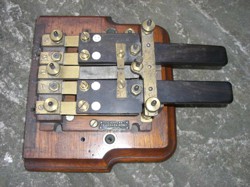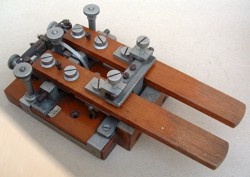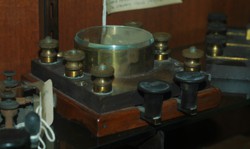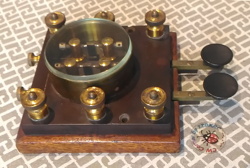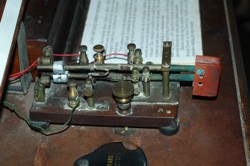Cable Keys
Cable telegraph keys have been in use since the first Transatlantic Cable was completed in 1858. The first thing that stands out when looking at a cable telegraph key is the fact that it has 2 levers, one for dots and one for dashes. One lever produces a positive current and the other a negative current. At the receiving end of the cable, this difference between positive and negative currents is used to decode the Morse signal.
One early method of decoding this signal involved the use of an Optical Galvanometer. A mirror was attached to a galvanometer coil suspended between 2 magnets. A positive current through the coil would cause the mirror to rotate one direction, and a negative current could cause the mirror to rotate in the opposite direction. A light was shined on the mirror which would reflect against a long horizontal ruler. Thus, the rotation of the mirror in either direction would deflect the light beam to the right or left depending on whether a dot or a dash was received. The operator would watch the movement of the light beam against the ruler to read the Morse signal. (Click here for a drawing of a mirror galvanometer, and here for an actual example of an instrument)
An improved method of reading cable signals came from using a Siphon Recorder. The Siphon Recorder used a small glass tube connected to an ink well to draw a line down the length of a paper tape. The siphon was attached to a coil much like with the Mirror Galvanometer. Changes in direction of current would cause the ink line created by the siphon to move towards one edge of the tape or the other depending on whether a dot or dash was received, thus giving a permanent record of the incoming signal. It took some practice to be able to read the decoded signal as it was not a sharp transition of the line in either direction. Capacitance on the cable caused a "smearing" of the incoming signal. You can see an example of this later. (Click here to see a drawing of a Muirhead Siphon Recorder, and here to see a picture of an actual instrument)
Using a hand cable key to send messages was rather slow, so to speed up the transmissions of cable messages, a paper tape was pre-punched with holes to represent a Morse signal and then fed through a Wheatstone Transmitter to automatically send the coded message. For an example of a Morse message from a Siphon Recorder as well as a pre-punched transmitting tape, click here (Above photos courtesy of atlantic-cable.com)
For everything you could possibly want to know about cable telegraph, please visit Bill Burns excellent website dedicated to the Atlantic Telegraph.
How to Identify a Cable Key:
Many collectors believe that any instrument that has 2 keys next to each other on a single base is a cable telegraph key. However, this is not the case. There are double keys that exist that were not used for cable telegraph. Examples include keys used with Double-Current systems, or keys that were simply used as laboratory switches. Some of the important identifiers of a genuine cable key are as follows:
1. A cable telegraph key will have a contact at the front and at the back of each of the 2 key levers and on the base. OR if there are no rear contacts on the key, the key will have a metal contact bridge over the 2 key levers with a contact screw for each lever.
2. The cable telegraph key will have 4 binding posts.
3. The two front contacts on the base are connected together, and the two rear contacts on the base (or the contacts on the bridge frame, if present) are also connected together.
 |
Close-Up of the Contact Bridge on an Elliott Brothers cable key. |
 |
Refer to the schematic of a cable key at the left. When both key levers are in the UP position, the cable is grounded. When the top key lever is in the DOWN position, a Negative voltage is applied to the cable. When the bottom key lever is in the DOWN position, a Positive voltage is applied to the cable. Note that the cable key has 4 binding posts. One binding post connects to the Front (Positive) contacts of the keys. One binding post connects to the Rear (Negative) contacts of the keys (or the 2 contacts on the metal contact bridge, if one is present). The metal frame of one key is connected to the cable line through a 3rd binding post, and the metal frame of the 2nd key is connected to Earth Ground through the 4th binding post. |
(Click on the pictures below to see larger versions of the photo)
 |
 |
 |
Classic style cable key by Elliott Brothers, London.
 |
 |
A similar style cable key by Muirhead & Company Ltd. |
 |
Another Cable Key by Muirhead & Company Ltd |
 |
 |
 |
Saunders' Signalling Key by Muirhead & Co.
 |
Another version of the Saunders' Signalling Key |
 |
 |
 |
Cable Key Marked Singpore Workshop
 |
 |
 |
|---|
Elliott Brothers key with knife-edge pivots (w1tp.com).
 |
 |
 |
Prussian double lever key with a pair of camelback keys. NOT a cable key. Note: This key could probably be used as a cable key if it was wired poperly through the external wiring connectors. More likely this key was designed to be used as a simple double key, although the intended purpose is unknown to me at this time. If someone can provide documentation as to how this key was used, please let me know.
 |
 |
 |
A small cable key that was found in Switzerland. Maker Unknown. |
 |
 |
Muirhead & Co key with locking mechanisms to hold down levers in transmit position. |
 |
 |
Silvertown cable key with sheet metal strap levers. Because of the stiffness of these levers, keys with this type of lever were generally used for cable testing rather than actual cable telegraphy. |
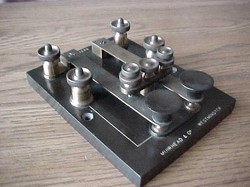 |
Muirhead & Co key with similar strap levers. |
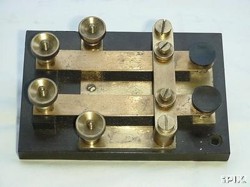 |
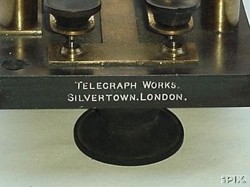 |
Early Silvertown cable key with strap levers. |
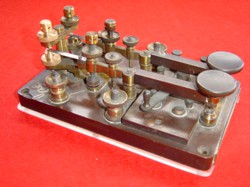 |
A more ornate British cable key. Maker unknown. |
 |
Another Unmarked cable key. Possibly made by Silvertown |
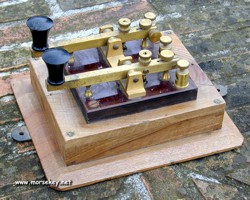 |
An Italian double key. Note that there are only 3 binding posts, so this is NOT a cable key. (IK6BAK collection) |
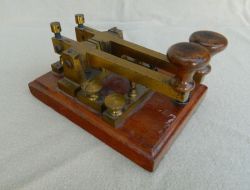 |
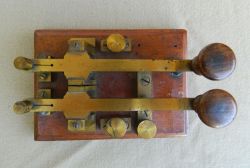 |
A German Key with 2 Levers. Note the lower rear contacts are not connected together, so this is NOT a cable key. |
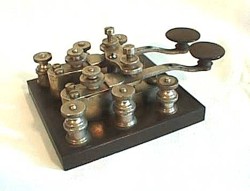 |
Western Electric cable key comprised of a pair of Steiner Keys. |
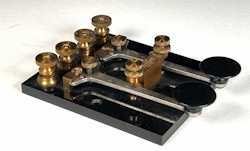 |
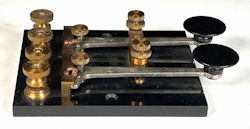 |
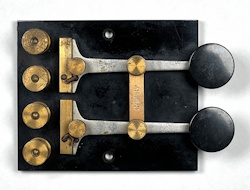 |
A cable key made by JH Bunnell, NY |
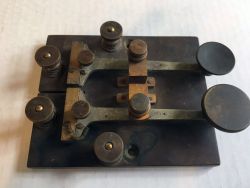 |
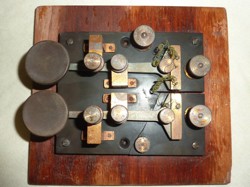 |
Two other versions of the Bunnell cable key. |
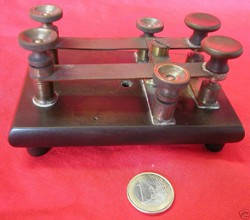 |
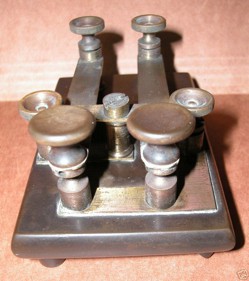 |
Unknown maker cable key. |
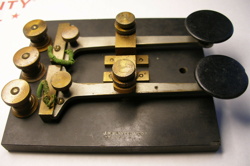 |
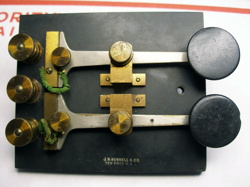 |
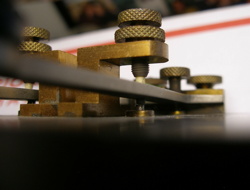 |
A key by JH Bunnell that looks very much like a cable key but the configuration is not correct for cable telegraph. It also has insuators in the upper travel-stop screws to prevent contact with the metal block. If anyone has information about the purpose of this key, please contact me.
Cable Testing Keys

